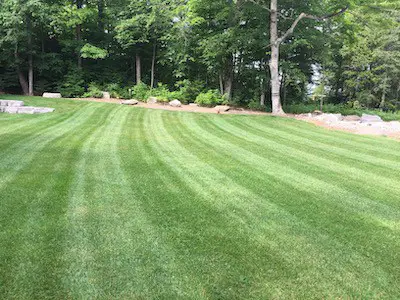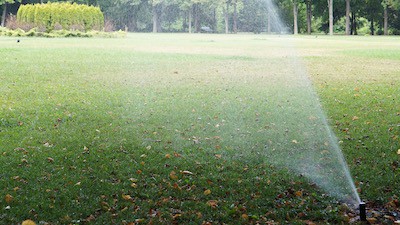Does Frequent Mowing Thicken Grass? Everything You Need to Know
There are a lot of different things that could be causing your lawn to perform poorly, and they aren’t always easy to point out. Many of us can mow and tend to our lawns on a routine basis in hopes for more productive growth, but still aren’t seeing the results that we are aiming for.
Does frequent mowing thicken grass? Yes, frequent mowing does thicken your grass. A little known fact is that the tips of blades of grass house hormones that keep it from being able to grow horizontally. Frequent mowing allows you to remove these tips this allow the grass to grow thicker and spread more freely. With some assistance from fertilizer, cutting your lawn at the right time, using the right methods will not harm the grass and will produce dense, healthy, and beautiful looking grass.
8 Other Ways To Thicken Grass in Your Lawn?
While you might be cutting your lawn often and the grass is growing at a fast rate, it doesn’t mean that it looks like the thick and luscious grass you’ve always dreamed of. You can easily still be dealing with sparse patches that make your yard look uneven and unappealing to the eye.
Take a moment to read further about some of the alternative ways you can achieve positive results for your lawn.
Fertilize Your Lawn
One of the most important things to do when striving for thick and healthy grass is to fertilize your lawn. With this crucial step, it is good to remember that with more fertilization, the more you will need to maintain. It is a very small price to pay for having the lawn you’ve always wanted.
When fertilizing your lawn, the first thing to do is use the correct type of spreader. A broadcast or rotary spreader generally does the job well in large open spaces. There are also alternatives to these kinds of fertilizers if the size of your yard is smaller.
A few days before you begin the fertilization process, you want to ensure that your lawn is thoroughly watered. Once the moisture has dried up, it is a good time to start laying down the fertilizer.
Once you have covered the whole yard, water your yard a second time but this time much less. This makes sure that the fertilizer is cleaned off of the blades of grass and soaked into the ground.
After the fertilizer has been laid, naturally fertilize your lawn by grasscycling. It is important to note that the clippings that are left behind from mowing your lawn can supply your grass with 1/4th of the nitrogen that it requires. Using mulching blades cuts the grass into much smaller pieces so that it can decompose more quickly.
The type of grass that you have in your yard plays a big part in how often this process needs to take place because the best time for it is as the grass peaks in growth. In the North, early fall is the best time for fertilizing. In southern states, you can fertilize your lawn in late spring or early summer.
Don’t Mow the Grass on a Low Setting
Mowing your lawn is not a bad thing in and of itself, but you want to avoid a routine schedule for mowing your grass. I recommend that you take some time to observe your grass and what state it’s in.
How fast is the grass growing? What season are you in? These questions will help you know when the proper time has come for you to mow, and you will most certainly see results.
Another thing to think of is how high you are cutting your grass. The height you should mow for a lawn that is established is very important during warmer months. When the weather is warm, you want to make sure the grass height is taller so that the grassroots are shaded.
This will protect the grassroots and encourages deeper growth of the roots. As the temperature starts to cool down, little by little, start lowering the blades of the mower to average mowing heights. In the fall, your grass will stop growing, so that’s when you should refrain from mowing your lawn at all.
If your lawn has new sod or is a new lawn that has just been seeded, the rules change. If your lawn has just been newly seeded, you want to wait around two months before you start any kind of mowing routine. The goal is for all of the seed to sprout and grow to one and one-half times its normal height.
For new sod, it’s a good idea to refrain from any mowing for about two weeks.

Irrigate Properly
The average lawn needs around 1 inch of rainfall every week to keep its thickness and lush appeal. This number also includes the supplemental precipitation that you provide through irrigation.
It’s important to note that water will move much more quickly into soils that are sandy and will go much deeper compared to soaking into clay.
Using the proper techniques for the maintenance of your lawn is the best way to keep your lawn healthy.
Over-seed To Thicken Your Grass
Overseeding is the process of you or distributing grass seed over dead or light spots in your lawn, and there are generally very positive results if it is done the right way. If you use your lawn regularly, thinning is normal and is a sign that your grass is maturing. When you overseed your lawn, it keeps it looking young and full of life without you having to start over completely.
Always pick grass seed that matches where you live and the climate you are in. You also want to pay attention to the conditions of your lawn before moving forward with overseeding.
Early Morning Waterings
Watering your lawn between 4 am and 10 am whenever you can reduce loss to evaporation and wind. This allows the moisture to soak deeply into the ground before the light from the sun starts to heat your soil.
Monitor Rainfall and Don’t Overwater
When you use weather data and rain gauges to keep track of how much natural water your lawns will absorb will show you exactly how much to supplement via irrigation. If you overwater your grass, the roots won’t get the oxygen that they need and you can easily start having problems with multiple types of lawn disease.
Distribute Water Equally
Making sure to distribute water equally and at a slow pace will help keep water off of paved areas as well as runoff or puddling. Sprinklers that water for a short period allows your grass to soak in the moisture before any of it has time to build up.
No matter what method you end up choosing, make sure you remember to watch your lawn closely before you make any final decisions. If your grass is dull or curled, it’s a good sign that your lawn is water-stressed. If your lawn stays depressed, you probably want to consider giving it more water. Your lawn will tell you what it needs.
Control Weeds To Thicken Your Grass
Lawn weeds are usually plants that are seasonal and grow in similar patterns to lawn grasses. Weeds that come in the warmer season like crabgrass, only survive for about one year. However, they make sure to leave behind many seeds that will give you weeds for the long term.
Alternatively to crabgrass, perennial weeds are around during the cooler season and can survive for multiple years. If nothing is done to treat them, they will also continue to spread seeds that will give you a weed problem for years and years to come.
The best time to attack the problem of weeds is during the fall because perennial weeds are still trying to store up reserves for their food supply. This makes them susceptible to treatment. The weed killers can be administered to the plant and the weeds will not be able to evade treatment.
These different types of weeds fight against your grass for water, nutrients, and sunlight. If you have a lot of weeds, it means that your lawn isn’t able to receive the proper amount of fertilizer and other important resources. Take control of the problem before it takes control of your lawn.
Conclusion
If you want to have a lawn that you can be proud of, remember that the most important thing you can do is to pay attention to what your lawn is saying. With the proper research and a good understanding of the conditions of your yard, you will be able to achieve all of your goals.



